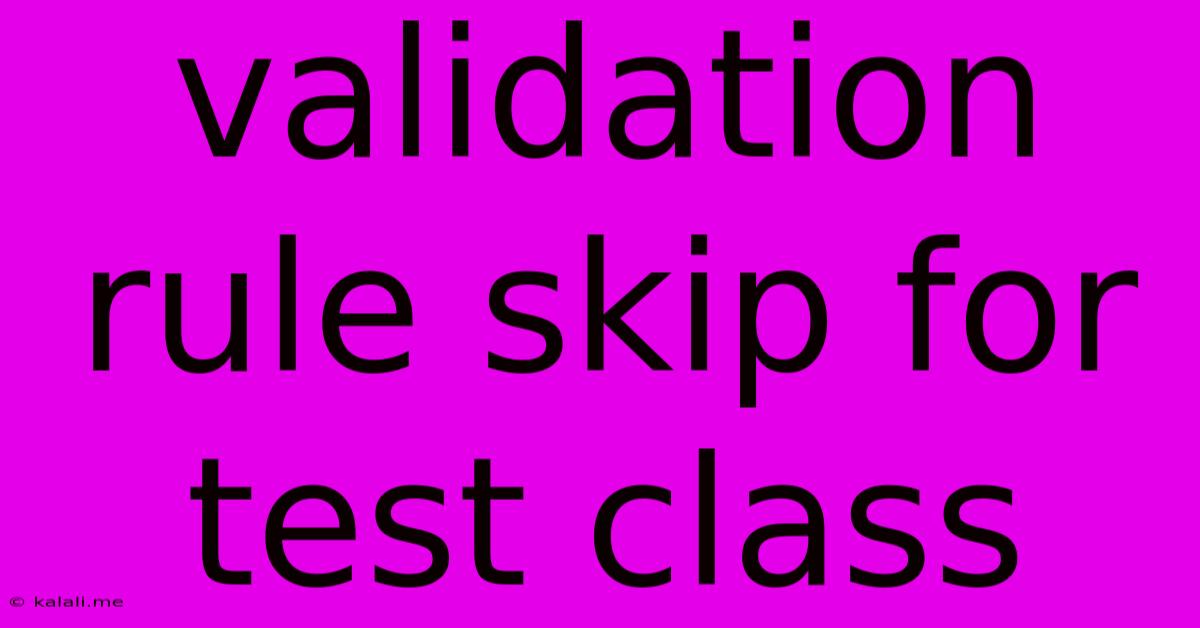Validation Rule Skip For Test Class
Kalali
May 23, 2025 · 3 min read

Table of Contents
Skipping Validation Rules in Apex Test Classes: A Comprehensive Guide
Meta Description: Learn how to effectively skip validation rules during Apex testing in Salesforce. This guide covers various methods, best practices, and considerations for clean, efficient test execution.
Testing Apex code in Salesforce often involves interacting with validation rules. While crucial for data integrity in production, these rules can sometimes hinder efficient test execution. This article provides a comprehensive guide on strategically skipping validation rules during your test class execution, ensuring faster and more reliable tests.
Why Skip Validation Rules During Testing?
Validation rules are designed to maintain data consistency. However, during testing, particularly when manipulating data for various test scenarios, these rules can lead to test failures unrelated to the code under test. Skipping validation rules temporarily allows you to:
- Focus on core logic: Isolate and test the specific functionality without interference from validation rules.
- Simplify test setup: Avoid cumbersome workarounds to satisfy validation rules during data creation.
- Improve test execution speed: Bypass the overhead of validation rule processing, leading to faster test runs.
- Handle edge cases: Test scenarios that might otherwise be blocked by validation rules.
Methods for Skipping Validation Rules
There are several effective ways to temporarily disable validation rules during your Apex test execution:
1. Using Test.setMock(false, false):
This method is generally not recommended for skipping validation rules. While Test.setMock() primarily controls mocking, setting both parameters to false can sometimes bypass validation rules. However, this approach is unreliable and may lead to inconsistent behavior. It's crucial to rely on more explicit and predictable methods.
2. Using Test.isRunningTest() Conditional Logic:
This approach involves writing conditional logic within your validation rule itself. It checks if the code is running within a test context and adjusts its behavior accordingly. This is a powerful technique for controlling validation rule behavior based on the environment.
trigger MyValidationTrigger on MyObject__c (before insert, before update) {
for (MyObject__c obj : Trigger.new) {
if (!Test.isRunningTest()) {
// Your validation logic here
if (obj.Field1__c == 'Invalid Value') {
obj.addError('Field1__c cannot be "Invalid Value"');
}
}
}
}
This method keeps the validation rule intact for production while allowing it to be effectively bypassed during tests.
3. Modifying Test Data to Satisfy Validation Rules:
This involves carefully crafting your test data to adhere to all validation rules. While seemingly straightforward, this approach can become complex and time-consuming, especially with numerous validation rules and intricate test scenarios. This method is only suitable for simple scenarios.
4. Using a Separate Test-Specific Validation Rule:
Create a separate validation rule specifically designed for testing purposes. This rule could be easily activated and deactivated depending on the environment. This method promotes cleaner separation of concerns and avoids compromising production validation rules.
Best Practices and Considerations
- Prioritize clear and well-defined tests: Focus on testing the core functionality, rather than attempting to bypass all validation rules indiscriminately.
- Document your approach: Clearly document the reasons for skipping validation rules in each test class, ensuring maintainability and transparency.
- Selective skipping: Only skip validation rules necessary for successful test execution. Avoid unnecessary bypassing.
- Maintain data integrity: While bypassing rules, ensure the data remains consistent within the test context to avoid unexpected behavior in later tests.
- Use a consistent strategy: Maintain consistency in your approach to skipping validation rules across all your test classes for improved maintainability.
By carefully selecting and implementing the appropriate method, you can effectively manage validation rules during Apex testing, improving efficiency and reliability without compromising the integrity of your production environment. Remember to prioritize well-structured, readable tests that clearly communicate their purpose and methodology.
Latest Posts
Latest Posts
-
What Is A Quarter Of A Million
Jul 02, 2025
-
Which Of The Following Is True Concerning A Dao
Jul 02, 2025
-
How Long Can Catfish Live Out Of Water
Jul 02, 2025
-
Is Kanye West Related To Cornel West
Jul 02, 2025
-
Olivia Needs To Provide A Visual Summary
Jul 02, 2025
Related Post
Thank you for visiting our website which covers about Validation Rule Skip For Test Class . We hope the information provided has been useful to you. Feel free to contact us if you have any questions or need further assistance. See you next time and don't miss to bookmark.